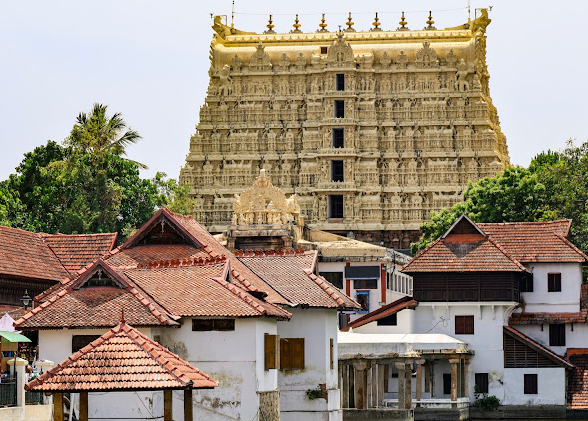The Padmanabhaswamy Temple is mentioned in several Hindu texts, including the Vishnu Purana, Brahma Purana, and Bhagavata Purana. It is also referenced in the Sangam period literature, where it is called the "Golden Temple," suggesting its immense wealth. Sangam Tamil poetry and later works by 9th-century Tamil poet-saints like Nammalwar praise the temple and the city for their golden walls, sometimes even eulogizing them as made of gold, with the temple described as a heavenly abode.
The temple is one of the 108 Divya Desams, sacred abodes of Vishnu, and is celebrated in the Divya Prabandha. Tamil poet Alvar Nammalwar glorified the Padmanabha in the 8th century.
Legend has it that Parasurama purified and venerated the idol of Sree Padmanabhaswamy during the Dvapara Yuga. He entrusted the temple administration to seven Potti families and assigned King Adithya Vikrama of Vanchi to protect the temple. The temple's Tantram was given to Tharananallur Namboothiripad, as narrated in the Kerala Mahathmyam.
Another version of the consecration story involves the sage Vilvamangalathu Swamiyar, who sought a divine darshan of Vishnu. He encountered Lord Vishnu in the form of a mischievous boy, who later guided him to Ananthankadu, where the Lord manifested as Anantha Sayana Moorti, reclining on the celestial serpent Anantha. The idol was later consecrated with the help of the local king and Brahmins, and the Ananthankadu Nagaraja Temple and Vilvamangalam Sri Krishna Swami Temple were built.
In 1680 AD, the Muslim marauder Mukilan invaded Venad and sought to plunder the temple's vaults. He was dissuaded by local Muslims loyal to the Venad royals. Later, Padmanabhan Thampi attempted to loot the vaults but was stopped when divine serpents appeared and scared off his mercenaries. The local people, led by Pallichal Pillai, resisted Thampi's forces, ensuring the temple's safety.
Travancore royal family :-
In the early 18th century, Anizham Thirunal Marthanda Varma succeeded his uncle, Rama Varma, as king of Travancore at the age of 23, following the suppression of the Ettuveetil Pillamar, a group of powerful lords who had conspired against the royal house. Marthanda Varma centralized the kingdom's rule and began the last major renovation of the Padmanabhaswamy Temple, with the idol being reconsecrated in 1731 CE (906 ME).
On 17 January 1750, Marthanda Varma formally surrendered the Kingdom of Travancore to Padmanabhaswamy, pledging that he and his descendants would serve as vassals to the deity, adopting the title 'Sree Padmanabha Dasa' (servant of Padmanabhaswamy). Female members of the royal family were called 'Sree Padmanabha Sevinis.' The king's donation to the temple was known as Thrippadi-danam. Upon his death at age 53, Marthanda Varma's final wishes reinforced this relationship, instructing that the kingdom remain dedicated to Padmanabhaswamy and that any future acquisitions be given to the temple.
